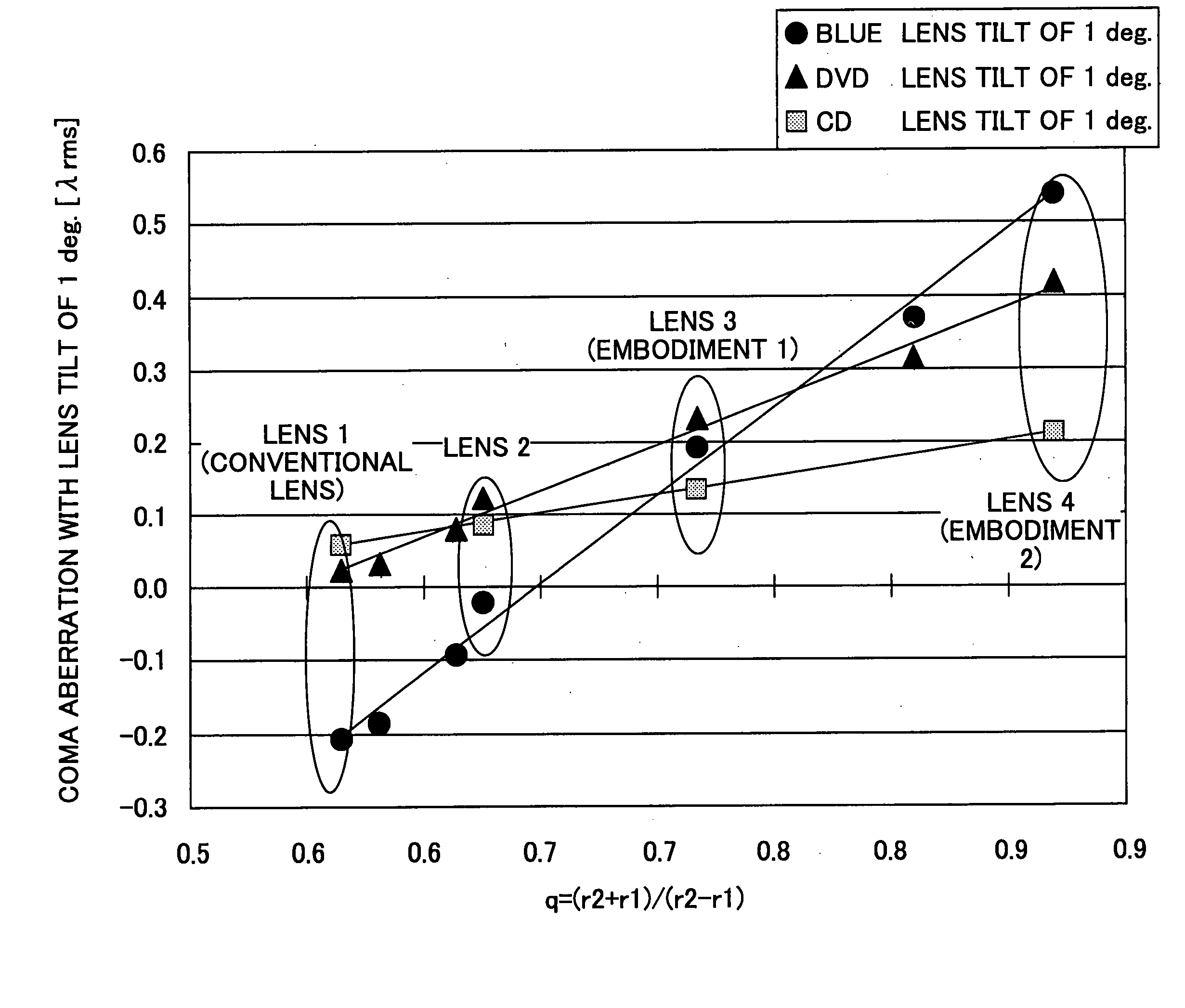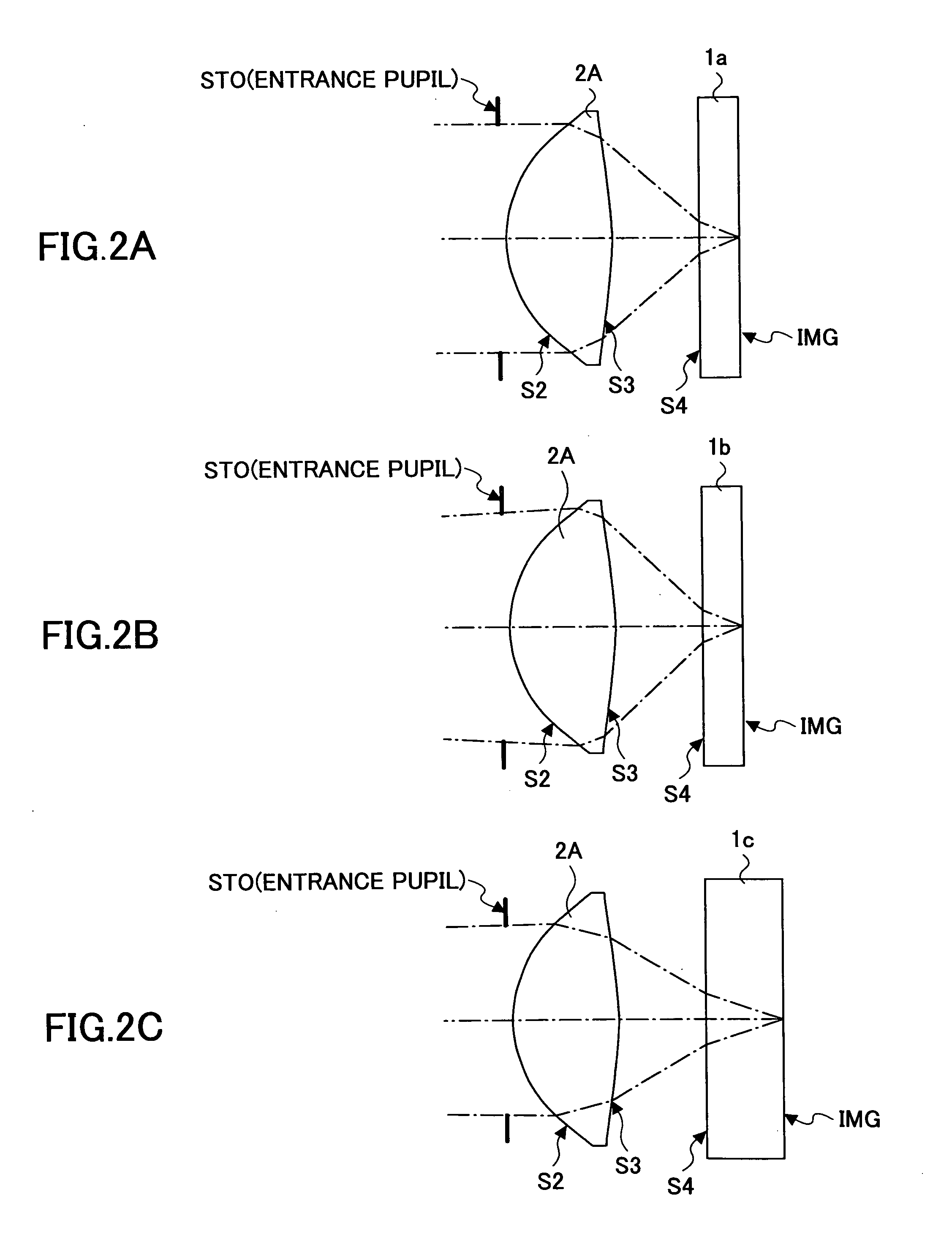Objective lens, optical pickup, and optical information processing apparatus
a technology of optical information processing and object lens, which is applied in the direction of instruments, optical beam sources, disposition/mounting of heads, etc., can solve the problems of coma aberration, inability to perform normal recording/reproduction operations, and difficulty in achieving size reduction and cost reduction with this method
- Summary
- Abstract
- Description
- Claims
- Application Information
AI Technical Summary
Benefits of technology
Problems solved by technology
Method used
Image
Examples
third embodiment
of the Objective Lens
[0117] This embodiment is described with reference to FIGS. 10 to 13. The objective lens 2C of this embodiment is used in an optical pickup for performing a recording process, a reproducing process or an erasing process on three types of optical recording media including a blue type optical recording medium 1a (wavelength (λ1): 405 nm, substrate thickness: 0.6 mm, numerical aperture (NA): 0.65), a DVD type optical recording medium 1b (wavelength (λ2): 660 nm, substrate thickness: 0.6 mm, numerical aperture (NA): 0.65), and a CD type optical recording medium 1c (wavelength (λ3): 785 nm, substrate thickness: 1.2 mm, numerical aperture (NA): 0.50).
[0118] The objective lens 2C of this embodiment is different from the objective lenses 2A, 2B of the first and second embodiments in that the objective lens 2C employs a one group two element configuration instead of a single element configuration. It is generally known that chromatic aberration can be corrected by apply...
first embodiment
[0126] This embodiment of the present invention is described with reference to FIGS. 14-24.
[0127]FIG. 14 is a schematic drawing of an exemplary configuration of an optical pickup for recording, reading out, and / or erasing information in an optical recording medium. The recording or reading out of the information by condensing a light beam from a fixed optical system 3 to an optical recording medium 1 via the objective lens 2 and obtaining signals of the light beam reflected from the optical recording medium 1 from a detecting system (not shown) provided in the fixed optical system 3. Furthermore, other than the fixed optical system 3, an actuator part 4 serving as a lens driving apparatus for tilting the objective lens 2 and a tilt detecting part 5 for detecting the tilt of the optical recording medium 1 are included in the optical pickup. The objective lens 2 is tilted by the actuator part 4 in accordance with the amount of tilt detected by the tilt detecting part...
second embodiment
[0155] This embodiment of the present invention is described with reference to FIGS. 32-34. The optical pickup of this embodiment is for performing recording, read-out, or erasing on two types of optical recording media including a blue type optical recording medium (wavelength λ1: 405 nm, NA: 0.65, thickness of light source side substrate: 0.6 mm) and a DVD type optical recording medium (wavelength λ2: 660 nm, NA: 0.65, thickness of light source side substrate: 0.6 mm).
[0156]FIG. 32 is a schematic drawing showing an exemplary configuration of an optical pickup 200 of this embodiment in relation to that shown in FIG. 15. The optical pickup 200 of this embodiment includes: a blue optical infinite system comprising a semiconductor laser 201 of the blue wavelength band, a collimator lens 202, a polarizing beam splitter 203, a dichroic prism 204, a deflecting prism 205, a ¼ wave plate 206, an aperture 207, an objective lens 208, a detecting lens 210, a beam dividing pa...
PUM
| Property | Measurement | Unit |
|---|---|---|
| thickness | aaaaa | aaaaa |
| thickness | aaaaa | aaaaa |
| wavelengths λ1 | aaaaa | aaaaa |
Abstract
Description
Claims
Application Information
 Login to View More
Login to View More - R&D
- Intellectual Property
- Life Sciences
- Materials
- Tech Scout
- Unparalleled Data Quality
- Higher Quality Content
- 60% Fewer Hallucinations
Browse by: Latest US Patents, China's latest patents, Technical Efficacy Thesaurus, Application Domain, Technology Topic, Popular Technical Reports.
© 2025 PatSnap. All rights reserved.Legal|Privacy policy|Modern Slavery Act Transparency Statement|Sitemap|About US| Contact US: help@patsnap.com



